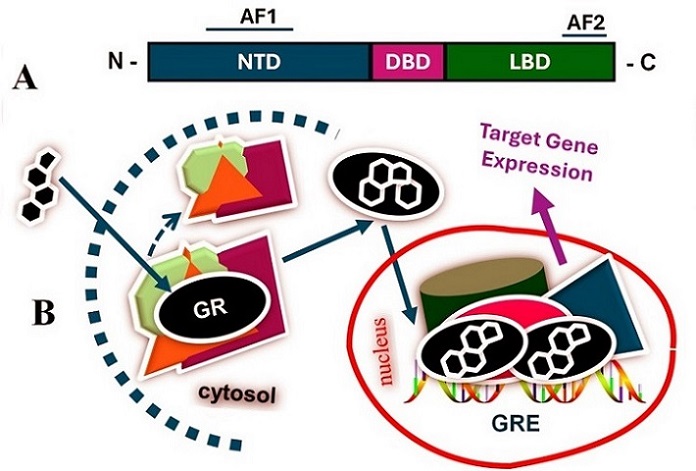New Hope in the Fight Against Triple Negative Breast Cancer as Scientists Uncover Dangerous Role of Glucocorticoid Receptor
Nikhil Prasad Fact checked by:Thailand Medical News Team Apr 16, 2025 3 hours, 56 minutes ago
Medical News: Triple-negative breast cancer (TNBC) is one of the most aggressive and deadly forms of breast cancer, affecting mostly younger women and disproportionately hitting African American women. It is defined by the absence of three common hormone receptors: estrogen (ER), progesterone (PR), and HER2. Without these targets, most conventional treatments are ineffective, leaving patients with very limited options beyond surgery and chemotherapy. Alarmingly, TNBC has much lower survival rates than other breast cancer subtypes, especially once it has spread to other parts of the body.
 New Hope in the Fight Against Triple Negative Breast Cancer as Scientists Uncover Dangerous Role of Glucocorticoid Receptor
New Hope in the Fight Against Triple Negative Breast Cancer as Scientists Uncover Dangerous Role of Glucocorticoid Receptor
A schematic diagram of the GR showing its major functional domains. (B) Model for the control of cell- and gene-selective transactivation with glucocorticoid (shown by four-fused aromatic rings in black) and GR. Ligand-free GR associated with chaperone proteins (colored geometric shapes) resides in the cytosol. The binding of the ligand modifies GR conformation, dissociating it from chaperones and allowing ligand-bound GR to translocate to the nucleus (shown by red circle), where it binds to the glucocorticoid response element (GRE) as a dimer. Coregulatory proteins (colored geometric shapes) then bind receptors either simultaneously or separately. The resultant GR/coregulatory protein complexes can then uniquely interact with other basal transcriptional machinery components, resulting in GR-mediated target gene expression.
Now, scientists from the Department of Pharmaceutical and Biomedical Sciences at Touro College of Pharmacy, Touro University in New York, have made a major breakthrough. In a new study, they have identified a troubling link between the glucocorticoid receptor (GR)—a protein that interacts with stress hormones—and poor survival outcomes in TNBC patients. This
Medical News report reveals that GR may not only promote cancer growth but also make tumors more resistant to chemotherapy, offering both a warning and a promising new path for treatment.
Why the Glucocorticoid Receptor Matters in TNBC
The glucocorticoid receptor is found in nearly every cell in the body and normally plays a role in managing inflammation, metabolism, and immune responses. But in TNBC, it appears to take on a dark new role. Unlike in other breast cancer subtypes where GR might help cells die off (a good thing in cancer treatment), in TNBC, GR seems to protect cancer cells and even help them spread.
The study explains that many patients with TNBC are given synthetic glucocorticoids—such as dexamethasone—before chemotherapy to reduce side effects. However, this may unintentionally activate GR, which triggers the expression of genes that help cancer cells survive and resist treatment. For example, the genes SGK-1 and MKP-1, both induced by GR, are known to prevent cancer cell death. In lab experiments using TNBC cell lines like MDA-MB-231 and animal models, treatment with glucocorticoids led to bigger tumors and made chemothe
rapy less effective.
A New Therapeutic Target Emerges
What makes GR especially dangerous in TNBC is its ability to interfere with chemotherapy, promote tumor growth, and block natural cell death. The researchers found that TNBC tumors with high GR expression were associated with higher mortality rates, faster recurrence, and greater drug resistance.
Interestingly, in other types of breast cancer that do have estrogen or progesterone receptors, GR expression has the opposite effect and is linked to better survival.
This makes GR a complex but potentially powerful target for therapy. Blocking GR in TNBC could be the key to improving patient outcomes. In fact, GR antagonists—drugs that stop GR from working—have already shown promise in making TNBC tumors more sensitive to chemotherapy. Additionally, new compounds like ganetespib, an Hsp90 inhibitor, may lead to the breakdown of GR and further improve responses to treatment.
Understanding How GR Works Inside Cancer Cells
At the molecular level, the GR operates like a switch that can turn genes on or off. When activated by hormones or synthetic drugs, it travels into the cell nucleus, binds to specific DNA sites, and interacts with helper proteins that control gene expression. In TNBC, this leads to the activation of genes that keep cancer cells alive and allow them to grow unchecked.
The study also found that the phosphorylation (chemical modification) of GR by enzymes like p38 MAPK could boost its cancer-promoting activity, including cell movement and tumor invasion. Inhibiting these interactions could offer another layer of therapy by stopping GR from doing damage even without hormone activation.
Looking Ahead
Triple-negative breast cancer remains one of the most difficult forms of cancer to treat, but this new research offers a much-needed sense of direction. By targeting the glucocorticoid receptor, scientists may be able to develop more effective therapies that halt the growth of TNBC and overcome chemotherapy resistance. More importantly, GR could serve as a valuable biomarker, helping doctors identify which patients are likely to face worse outcomes and who might benefit from GR-targeted therapies.
In conclusion, the study suggests that the glucocorticoid receptor is not just a passive player in TNBC but a driving force behind its deadly nature. Suppressing GR activity, either through direct antagonists or supporting agents like Hsp90 inhibitors, could become a critical part of future TNBC treatment strategies. With ongoing clinical trials and further research, there is hope that this knowledge could soon lead to more effective therapies and improved survival for TNBC patients around the world. Understanding and intervening in the molecular behavior of GR could finally turn the tide against this relentless disease.
The study findings were published in the peer reviewed journal: Receptors.
https://www.mdpi.com/2813-2564/4/2/8
For the latest on Breast Cancer, keep on logging to Thailand
Medical News.
Read Also:
https://www.thailandmedical.news/news/study-shows-that-the-phytochemical-calycosin-extracted-from-red-clover-and-astragalus-propinquus-plants-can-help-prevent-breast-cancer-metastasis
https://www.thailandmedical.news/news/global-breast-cancer-imaging-and-screening-market-set-to-explode-as-cancer-rates-increase
https://www.thailandmedical.news/news/breaking-new-study-shows-even-progestin-only-birth-control-pills-or-patches-increase-risk-of-breast-cancer
https://www.thailandmedical.news/articles/cancer
https://www.thailandmedical.news/pages/thailand_doctors_listings
